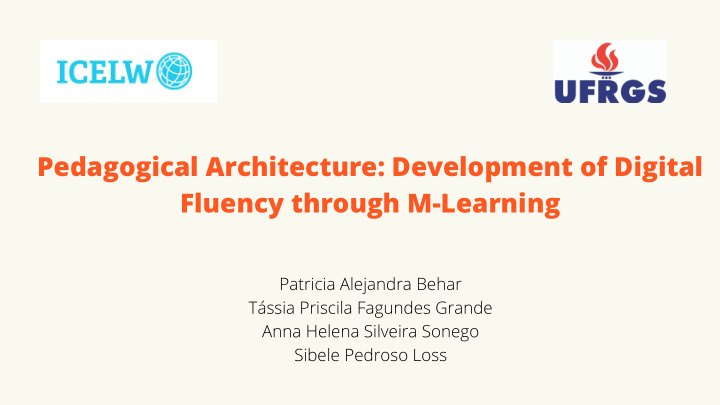



Pedagogical Architecture: Development of Digital Fluency through M-Learning Patricia Alejandra Behar Tássia Priscila Fagundes Grande Anna Helena Silveira Sonego Sibele Pedroso Loss
AIM OF RESEARCH This paper deal with the construction of a pedagogical architecture to assist teachers and students in the development of digital fluency through mobile learning.
100% CONTEXTUALIZATION 75% The smartphone appears in the first position as a means to acess the internet 50% (92%), followed by notebook (29%), and tablet (16%). 25% 0% Smartphone Computador Tablet (TIC DOMICÍLIOS, 2019)
M-learning Learning that can occur at any time and place with teacher's guidance and use of a mobile device.
"The role of ICT is to contribute to "decrease" this "pedagogical distance", ensuring forms of communication and interaction between "actors" involved in knowledge building process by distance education". BEHAR ET AL [5]
PEDAGOGICAL ARCHITECTURE FONTE: BEHAR ET AL (2009)
DIGITAL FLUENCY COMPETENCE WITH FOCUS ON M-LEARNING
Methodology • An qualitative case study aproach; •The case study made the implementation of a pedagogical architecture to distance education possible, with the aim to assist in the development of digital fluency through use of mobile devices and especific application. • Target audience: 30 undergraduate students of various different courses from a Brazilian public university, aged 19 to 40 years; •Data collection was performed in 2019/2, in a semi-presential, elective discipline. •Were planned three proximate meetings and twelve at a distance.
Methodology The course was conducted in a distance-learning manner with its activities mediated through a virtual learning environment (VLE), in this case ROODA. Utilized Tools: Participant observation; Questionnaire with open and closed questions. The data allowed the analysis of the PA according to the following categories: organizational aspects; content aspects; technological aspects; methodological aspects; analysis of the application as to its usefulness and relevance in the discipline.
ANALYSIS After the implementation of the PA developed for a distance learning AND discipline focusing on the use of mobile devices in the classroom, we verified the RESULTS necessary components to compose a CHA.
Pedagogical Architecture to assist in the development of digital fluency through M-learning.
DIGITAL FLUENCY COMPETENCE WITH FOCUS ON M-LEARNING
ORGANIZATIONAL ASPECTS
CONTENT ASPECTS
METHODOLOGICAL ASPECTS
TECHNOLOGICAL ASPECTS
APP' SCREENS FIGURE 1 FIGURE 2
ANALYSIS AND RESULTS The PA building may enable teachers with conditions for the creation of methods, means and procedures. New forms of organization arise for the teaching and learning processes, giving support to the development of student knowledge. Methodological and technological aspects do not just determine techniques, procedures and computer resources to be planned and implemented in class.
CONCLUSION It was presented a discussion about the concepts of a pedagogical architecture for distance education in order to provide opportunities for the development of a digital fluency competence for m-learning. It was necessary to plan and implement a PA to assist teachers and students to develop a digital fluency competence through the use of mobile devices. The elaboration of an architecture becomes relevant to guide and encourage teachers who wish to perform activities with MD in distance learning courses.
CONCLUSION It is clear that the development of a digital fluency competence focused on m-learning is relevant, considering that among the features of mobile devices, one of the most used are apps; An application can help in the organization and availability of materials according to ease of navigation, expanding the ways to access content, activities and information on the discipline through the use of mobile devices.
References BEHAR, P. A. e colaboradores. Modelos Pedagógicos em Educação a Distância. Porto Alegre: Artmed, 2009. COMITÊ GESTOR DA INTERNET NO BRASIL. TIC Domicílios 2017. Pesquisa sobre o uso das tecnologias da informação e comunicação nos domicílios brasileiros [livro eletrônico] São Paulo: 2018. BEHAR, P. (Org.). Competências em educação a distância. Porto Alegre:Penso 2013. 312 p.
Pedagogical Architecture: Development of Digital Fluency through M-Learning Patricia Alejandra Behar Tássia Priscila Fagundes Grande Anna Helena Silveira Sonego Sibele Pedroso Loss
Recommend
More recommend